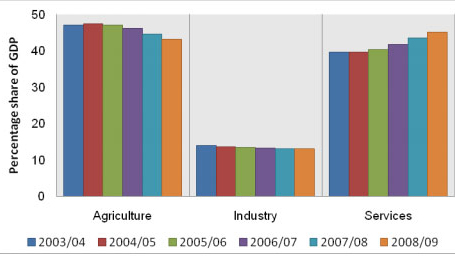3.2 The Ethiopian economy
The Ethiopian economy has undergone rapid transformation since 2003/2004. GDP has grown at an average annual rate of 11% over the decade to 2012, making the country one of the fastest-growing in the world (UNDP, 2012). The poverty level in the country declined from 38.7% in 2005 to 29.6% in 2012 (WHO, 2014). The country has an ambitious plan to be a middle-income country by 2025.
In Ethiopia, agriculture has traditionally provided the biggest share of GDP, as the country is in the early stages of economic development. However, Figure 3.4 shows that agriculture’s share of GDP declined slightly from 2003/4 to 2008/9. This does not mean that the overall agricultural production decreased, but its contribution to the country’s overall GDP went down relative to other areas, particularly the service sector. The share of GDP earned by the service sector, such as retail, banks, hotels and real estate, grew rapidly over this time. The industrial sector makes up a smaller percentage of GDP and has remained relatively static at between 13% and 14%.

There are many factors that have driven Ethiopia’s rapid economic development, including:
- favourable weather conditions for agriculture in the past decade and an increase in land area under cultivation
- investment to improve schools, health facilities, roads, telecommunications and the energy sector
- diversification of exports from only a few commodities, such as coffee, to other commodities including oilseeds, flowers, animals and animal products
- increased remittances from Ethiopians living abroad
- increased tax revenue collection and more development aid from external donors
- government policies that focus on infrastructure development, commercialisation of agriculture and private sector development(Ncube et al., 2010).
Among the most relevant government policies is the Growth and Transformation Plan (GTP). This was introduced in 2010 to run for the five years up to 2015, coinciding with the timeframe of the Millennium Development Goals. It is followed with a second phase, GTP II. The GTP aims to improve the national economy and bring an end to poverty by increasing opportunities for commercial agriculture, large-scale industry and infrastructure development.
Do you think that Ethiopian economic growth (GDP increase) has translated to human development? What figures can you use to back up your answer?
Yes. To mention some figures, the HDI has increased by 32%; the poverty level declined from 38.7% in 2005 to 29.6% in 2012, and the country is on track to achieve six of the eight MDGs.
Despite the positive trends, Ethiopia’s economy is still vulnerable to climate-induced shocks (UNDP, 2012). Although the dominance of the agriculture sector is slowly declining (as shown in Figure 3.4), the country’s economy still depends on rain-fed agriculture. This means that if the rains fail the loss of crops can have disastrous results. To overcome these problems requires a more resilient economy; this will be discussed in Study Session 12.
3.1 Economic growth, economic development and human development
